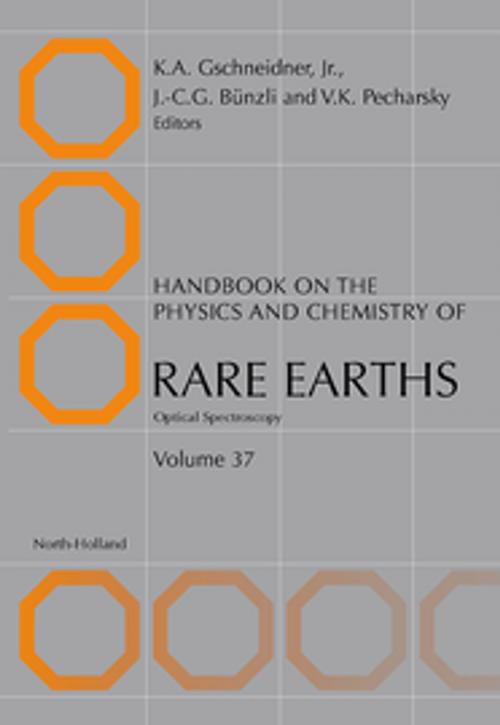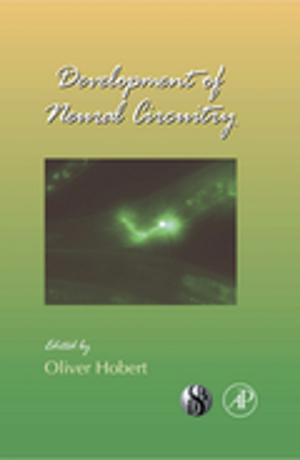Handbook on the Physics and Chemistry of Rare Earths
Optical Spectroscopy
Nonfiction, Science & Nature, Science, Chemistry, Inorganic, Physics, General Physics| Author: | Vitalij K. Pecharsky, Karl A. Gschneidner, B.S. University of Detroit 1952Ph.D. Iowa State University 1957, Jean-Claude G. Bunzli, Diploma in chemical engineering (EPFL, 1968)PhD in inorganic chemistry (EPFL 1971) | ISBN: | 9780080548586 |
| Publisher: | Elsevier Science | Publication: | September 22, 2011 |
| Imprint: | North Holland | Language: | English |
| Author: | Vitalij K. Pecharsky, Karl A. Gschneidner, B.S. University of Detroit 1952Ph.D. Iowa State University 1957, Jean-Claude G. Bunzli, Diploma in chemical engineering (EPFL, 1968)PhD in inorganic chemistry (EPFL 1971) |
| ISBN: | 9780080548586 |
| Publisher: | Elsevier Science |
| Publication: | September 22, 2011 |
| Imprint: | North Holland |
| Language: | English |
Optical spectroscopy has been instrumental in the discovery of many lanthanide elements. In return, these elements have always played a prominent role in lighting devices and light conversion technologies (Auer mantles, incandescent lamps, lasers, cathode-ray and plasma displays). They are also presently used in highly sensitive luminescent bio-analyses and cell imaging. This volume of the Handbook on the Physics and Chemistry of Rare Earths is entirely devoted to the photophysical properties of these elements. It is dedicated to the late Professor William T (Bill) Carnall who has pioneered the understanding of lanthanide spectra in the 1960’s and starts with a Dedication to this scientist. The following five chapters describe various aspects of lanthanide spectroscopy and its applications. Chapters 231 presents state-of-the-art theoretical calculations of lanthanide energy levels and transition intensities. It is followed by a review (Chapter 232) on both theoretical and experimental aspects of f-d transitions, a less well known field of lanthanide spectroscopy, yet very important for the design of new optical materials. Chapter 233 describes how confinement effects act on the photophysical properties of lanthanides when they are inserted into nanomaterials, including nanoparticles, nanosheets, nanowires, nanotubes, insulating and semiconductor nanocrystals. The use of lanthanide chelates for biomedical analyses is presented in Chapter 234; long lifetimes of the excited states of lanthanide ions allow the use of time-resolved spectroscopy, which leads to highly sensitive analyses devoid of background effect from the autofluorescence of the samples. The last review (Chapter 235) provides a comprehensive survey of near-infrared (NIR) emitting molecular probes and devices, spanning an all range of compounds, from simple chelates to macrocyclic complexes, heterometallic functional edifices, coordination polymers and other extended structures. Applications ranging from telecommunications to light-emitting diodes and biomedical analyses are assessed.
- Provides a comprehensive look at optical spectroscopy and its applications
- A volume in the continuing authoritative series which deals with the chemistry, materials science, physics and technology of the rare earth elements
Optical spectroscopy has been instrumental in the discovery of many lanthanide elements. In return, these elements have always played a prominent role in lighting devices and light conversion technologies (Auer mantles, incandescent lamps, lasers, cathode-ray and plasma displays). They are also presently used in highly sensitive luminescent bio-analyses and cell imaging. This volume of the Handbook on the Physics and Chemistry of Rare Earths is entirely devoted to the photophysical properties of these elements. It is dedicated to the late Professor William T (Bill) Carnall who has pioneered the understanding of lanthanide spectra in the 1960’s and starts with a Dedication to this scientist. The following five chapters describe various aspects of lanthanide spectroscopy and its applications. Chapters 231 presents state-of-the-art theoretical calculations of lanthanide energy levels and transition intensities. It is followed by a review (Chapter 232) on both theoretical and experimental aspects of f-d transitions, a less well known field of lanthanide spectroscopy, yet very important for the design of new optical materials. Chapter 233 describes how confinement effects act on the photophysical properties of lanthanides when they are inserted into nanomaterials, including nanoparticles, nanosheets, nanowires, nanotubes, insulating and semiconductor nanocrystals. The use of lanthanide chelates for biomedical analyses is presented in Chapter 234; long lifetimes of the excited states of lanthanide ions allow the use of time-resolved spectroscopy, which leads to highly sensitive analyses devoid of background effect from the autofluorescence of the samples. The last review (Chapter 235) provides a comprehensive survey of near-infrared (NIR) emitting molecular probes and devices, spanning an all range of compounds, from simple chelates to macrocyclic complexes, heterometallic functional edifices, coordination polymers and other extended structures. Applications ranging from telecommunications to light-emitting diodes and biomedical analyses are assessed.
- Provides a comprehensive look at optical spectroscopy and its applications
- A volume in the continuing authoritative series which deals with the chemistry, materials science, physics and technology of the rare earth elements















